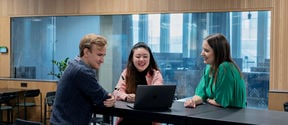Dialogue, trust, and shared understanding key ingredients in successful co-creation
Digital services can change the game in traditional industries. We have seen the examples of Uber in the tax industry and AirBnB in the hotel industry. Digitalization has also reached the construction industry. The maturity of digitalization in the construction sector has come in the form of building information modeling (BIM) which is a digital representation of the physical and functional characteristics of the building. Thus far, BIM has been mainly applied in the design and construction phases of a building. Now, BIM is developed enough to be adopted also in the operation and maintenance of the building. The use of BIM in facilities management (FM) can reduce building life-cycle costs and increase the performance of the building. BIM opens up new digital service business possibilities for the construction sector parties. BIM also helps the parties to move towards value-added thinking, instead of just focusing on cost efficiency. However, it has not been a trivial task for the construction sector parties to develop customer-centered digital services for FM.
Lavikka et al. (2016) studied the successful co-creation process of a customer-centered digital service. The context of the research was a complex medical center construction project in San Francisco, California. The co-creation took place between several companies and the customer that was represented by a facilities management team. In co-creation, the parties interact in several ways and share knowledge about their needs. Co-creation is thus reciprocal in nature, and the end result of it is a product or service that creates value for all the parties.
Three processes for successful co-creation
Lavikka et al. (2016) found that the successful co-creation of digital services for FM consists of three processes: 1) Dialogue, 2) Trust building, and 3) Shared understanding. Dialogue process refers to communication between the project parties and shared learning. One of the FM team members functioned as a liaison between the other project parties and the FM team. The liaison was essential in ensuring that the FM team was given a chance to review and comment on design solutions from the FM’s point of view. The FM team members had both FM and construction experience which was considered necessary in communicating the FM’s point of view to other project parties.
The continuous dialogue was essential in building good relationships. The project team gave the FM team access to project documentation, such as designs, the meeting schedules and meeting minutes, to help the FM team find the right meetings to attend and provide feedback on design solutions. The FM team members provided their view and feedback in a constructive manner. This built trust between the FM team and other project parties.
One of the FM team members was considered patient, well-spoken, collaborative, and able to understand the views of other project parties. These traits helped in building a shared understanding about the needs of FM and the contractors’ ways of satisfying those needs. The fact that the project parties were co-located and made decisions collaboratively provided an ideal platform for different project parties to learn about the needs of each other. The shared understanding was also enhanced by the contractor’s transparency of costs and risks involved in the co-created digital service. Figure 1 illustrates the results of the study.
Figure 1. A framework for successful co-creation of digital services with and for FM.
It needs to be noted that regardless of the continuous dialogue and trust built between the FM team and the service providers, one of the service provider companies could not take part in the co-creation process. The reason was that the contracts did not have enough contingencies to compensate for the additional working hours required by co-creation. Thus, the study implies that contracts should have contingencies to allow co-creation financially.
For more information contact Rita Lavikka
Reference
Lavikka, R., Lehtinen, T. & Hall, D. (2016) Co-creation of digital services with and for facilities management in construction projects. Proceedings of the Engineering Project Organization Conference, Cle Elum, WA, June 28-30, 2016. Kaminsky, J. & Zerjav, V. (eds.). Cle Elum, WA, USA, 18 p. (Working Paper Series).
Acknowledgements
The paper was written during Dr. Lavikka’s research visit to Stanford University which was funded by three institutions: 1) the Finnish Science Foundation for Economics and Technology, 2) the Finnish Cultural Foundation as part of PoDoCo program, and 3) the Digital Disruption of Industry (DDI) research project funded by the Strategic Research Council at the Academy of Finland. Lavikka works in the DDI project as part of the Enterprise Simulation Laboratory SimLab at Aalto University. Lavikka is also grateful for CIFE (Center for Integrated Facility Engineering) and GPC (Global Projects Center) at Stanford University, the USA for all the support throughout the research process.
- Published:
- Updated:
Read more news

Bio-based opacifiers offer solutions to cleaner environment
The CELLIGHT project, backed by approx. €1.3 million in funding from Business Finland, aims to develop cellulose-based alternatives to titanium dioxide (TiO2 ), a widely used whitener in paints, cosmetics, and coatings.
Major European funding for research into new quantum materials
New materials are hoped to become building blocks for yet unseen quantum devices
Call for doctoral student tutors, November 2024
Sign-up to be a tutor for new doctoral students as part of the Aalto Doctoral Orientation Days!